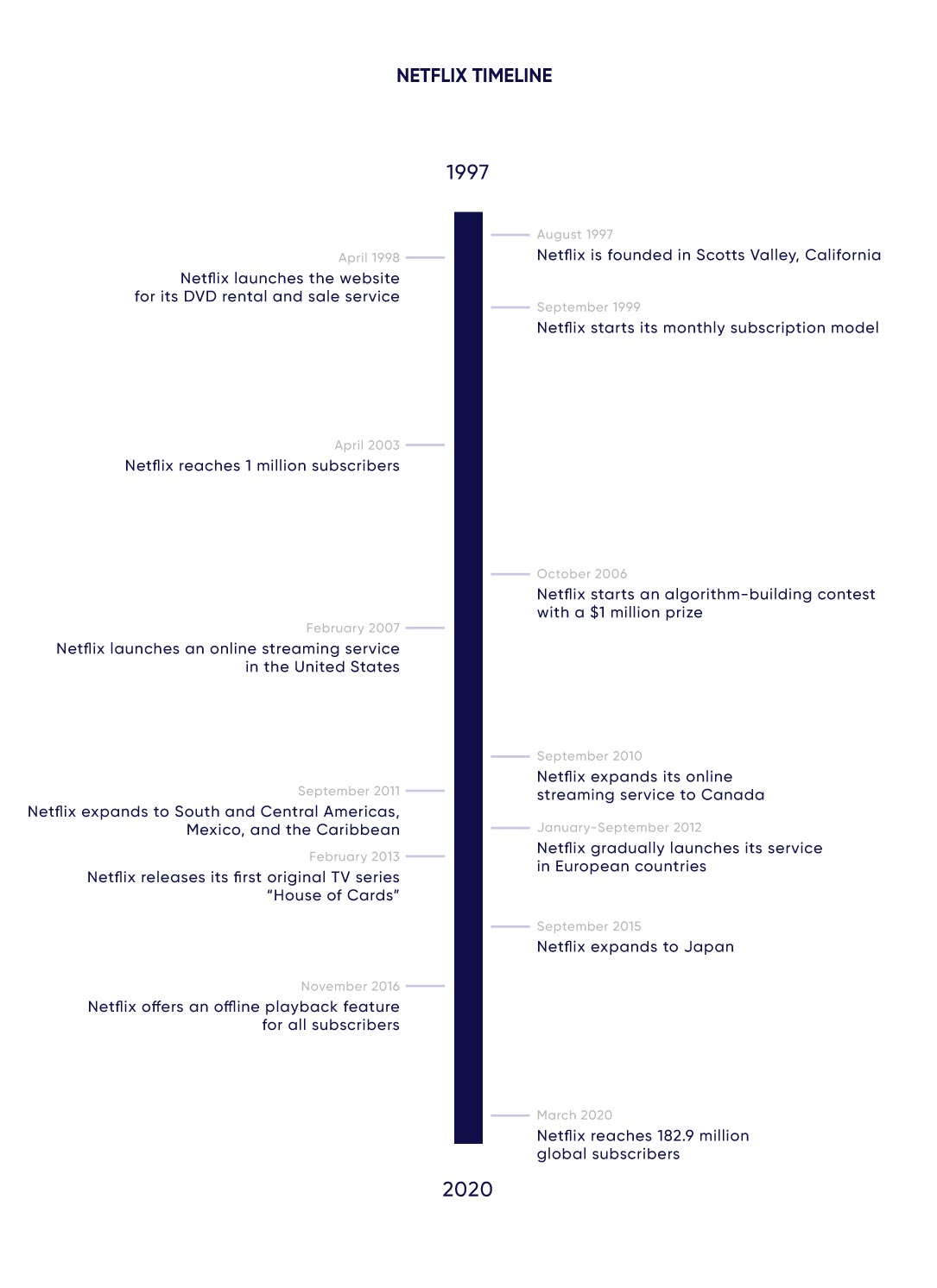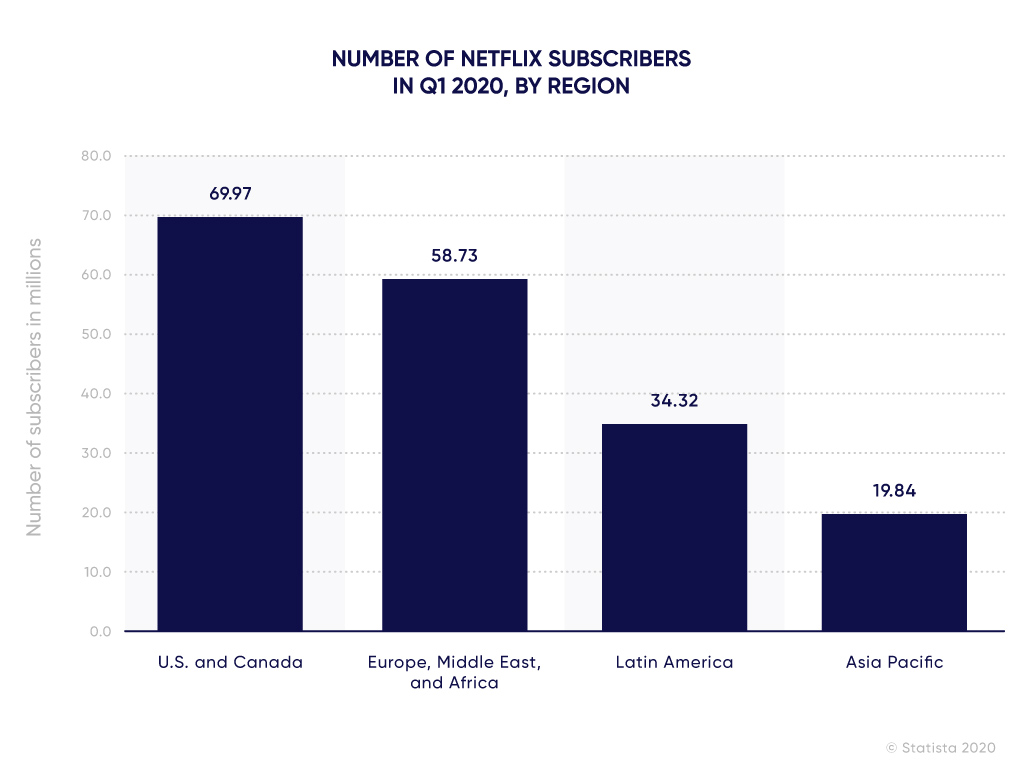It has been over a decade since video streaming services started to dominate over conventional television. They evolved from slow and clunky movie streaming websites into extensive libraries equally available at homes, on wearables and smartphones, or in vehicles. Let’s find out how to create a Netflix-type service and successfully compete in the booming video streaming business.
Netflix history
To understand the reasons for Netflix’s success and its transformation into a world leader of video streaming, let us take a brief look at its history. This way, we will learn more about strategic moves and management decisions that proved to be beneficial for the company.

Netflix started in 1997 as a DVD rental and sale service that operated from California via mail. While the company eventually dropped disk sales, the DVD and Blu-Ray rental business became the source and inspiration for the development of the company’s business model.
In order to beat the Blockbuster company, its closest competitor, Netflix quickly adopted many technological advances. From 2006 till 2009 the company held an open competition with a 1 million dollar prize and several “progress prizes” to create an improved rating prediction algorithm to replace its previous one called Cinematch. This event was a successful promotional move and a wise investment in digital technologies. The algorithm allowed providing better user experience by suggesting relevant video content more accurately for every particular customer.
At the same time, Netflix began switching its business focus from the delivery of disks by mail towards providing on-demand video content online. This way, the company provided essentially the same service – the access to the video content – but without the fuss related to physical disks and mail.
In 2007 Netflix launched a video streaming service that operated simultaneously with its rental business. In just one year, from March 2010 to April 2011, Netflix gained over 9 million subscribers, and its user base reached 23 million people in the United States and even more worldwide. Over the years, the company extended globally, and nowadays it has over 182 million users in over 190 countries.

Perhaps the most definitive step for Netflix was the decision to engage in creating movies and TV series. The original content produced by the company and available exclusively for its subscribers was a great addition to the enormous base of existing licensed videos. The first title created under the “Netflix Originals” initiative was the “House of cards” TV series that appeared in early 2013.
As you can see, the early adoption of new technologies, flexible business strategy, and effective promotion led to the current dominance of Netflix among other video streaming services. Now, it is natural that its success story is used as a base for many startups that want to enter similar markets and develop an app like Netflix.
How does Netflix streaming work?
In brief, Netflix offers access to a large library of video content using a subscription-based model. On-demand videos have a DRM protection and are encoded using several encryption profiles that vary depending on the type of a target device. One of the characteristic features is that all content is available even with the cheapest subscription plan. More expensive plans offer higher bitrates and support streaming on several devices simultaneously.
How to create a streaming app like Netflix
The process of building a video streaming application is generally the same as creating any other type of software, such as a radio station app, for example. It includes such stages as idea definition, search for a team, planning stage, UI prototyping, application development and testing, release and post-release support.
Business strategy and monetization models for video streaming services
If you want to repeat the success of Netflix you need to think through your business strategy. The market is already full of streaming services offered by such corporations as Disney, Amazon, and many others. If you want to succeed on the market you need to offer the potential audience something unique or at least better than the existing services.
The vast majority of services cover the general audience, which is more than a logically justified strategy. However, for the last few years, all markets look into personalizing user experience and offers. Thus, consider covering one of several niches and narrow down your target audience. For example, you may choose a niche:
-
Sports (in general or just one sport, like soccer, MMA, etc.);
-
Short and long documentaries with the pure scientific purpose;
-
TV series (in general or a single type: sitcoms, drama, fantasy/sci-fi, etc.);
-
Scientific shows that combine educational and entertainment aspects like Mythbusters, Ultimate Survival, etc.;
-
DIY video manuals, master classes, workshops, etc.;
-
Health and nutrition, such as cooking shows, yoga classes;
-
Business news, analytics, forecasts, etc.
As for monetization, you can choose a subscription model and offer various packages based on:
-
quality of the video stream;
-
possibility to use your service on multiple devices simultaneously;
-
quantity of available content; for example, different subscription plans may offer full or partial access to your media library, etc.
It is a common practice that a monthly subscription is more expensive in terms of cost per month than the annual or quarterly variants. However, such division brings certain levels of flexibility to users and provides several options to choose from, depending on the budget. This way, more people will be able to afford subscriptions and the number of loyal customers will grow steadily. Using this method, Netflix managed to achieve a steady increase of revenue every year that reached 20.15 billion U.S dollars in 2019.

The additional monetization ways can include:
-
access to extra features and quality-of-life improvements (like additional filters, offline mode, etc.);
-
advertising and ad removal, similar to YouTube (not recommended);
-
multi-language audio and subtitles, etc.
Functionality and features for your app
It is important to keep in mind that the number of features defines the time and money required to build an application. The abundance of features may also impact the app’s performance, so finding a balance is the key.
Main functionality
Sign up/login
Multiple sign up and login options are a must for every respectable service. By giving a user two or three convenient options you will increase the quality of user experience, the most common signup and login options are:
-
Entering email and password;
-
Signing up and logging in via personal social pages;
-
Entering PIN.
To protect your users from frauds, you can add two-step verification.
Personal profile
You can offer many things for profile personalization, such as:
-
Entering personal information like preferences and age (if your streaming service has adult content you can adjust the algorithm not to show it to users under 18);
-
Archive on viewed videos (can be divided into separate groups like recently viewed, in progress, etc.);
-
Archive on user’s ratings, comments, and reviews;
-
History on payment transactions (by showing users information on every transaction you can increase brand trust and customer loyalty);
-
Favorites list;
-
“View later” list, etc.
Payment
Your payment page must be as user-friendly and convenient as possible. It should include available subscription plans with detailed information, several payment options, assistance, etc.
Your payment functionality should be integrated with a reliable CRM system that would process actions and requests related to payment, send data on transactions to a database, and provide you with reporting.
Recommendation algorithms
Based on what video users select for view, their information in personal profiles, and other information, you can develop an advanced recommendation algorithm that would offer relevant content and increase client satisfaction. Also, your algorithm can suggest users the content that may be interesting to them but is only partially related to their preferred content. For example, if a user has watched the Witcher series, your algorithm may suggest watching the Game of Thrones or a documentary on medieval history or weaponry.
Search and Filters
Search is one of the core functionalities on the client side of your video streaming service. In addition to the search bar, your application should definitely comprise voice search as the main feature. You can include various filters to make searching more convenient for your users. This way, users will have the opportunity to filter the available video content by:
-
Type (feature film, documentary, cartoons, TV series, TV programs);
-
Genre (comedy, drama, action, etc.);
-
Seasons and Episodes (for TV shows and series);
-
Language, etc.
Genre division
Netflix has it as one of the main functionalities for a reason. Genre is commonly the primary search criteria for the majority of users. Thus, giving fast access to videos sorted by genre should be essential for your streaming service even if you don’t want to make it like Netflix.
Moreover, the genre division may provide the base for several monetization plans for your future streaming service. For example, cheaper “topical” plans may provide access to one genre of the available video content, such as sports, music, cartoons, while the “full” subscription plan will give access to the whole media library.
Offline Mode
The offline mode is an extremely popular feature among mobile users. It is the long-requested ability to legally download a movie or a season of a TV show to watch it later without having to connect to the Internet.
Additional features
Languages and Subtitles
Even if you don’t intend to cover more than one country with your app, we still advise you to include multi-language functionality to your app. Localization may cause additional expenses on research and development but it will help you to cover a bigger audience and go international with ease.

Subtitles are a must for a video streaming service like Netflix, and you shouldn’t underestimate their importance for the users. According to NIDCD (National Institute on Deafness and Other Communication Disorders), about 15% of adult American citizens report hearing problems. Therefore, just by not having subtitles in video content you limit the target audience diversity with your own hands.
Advanced search
Here are just a few examples of additional search filters:
-
Year of release;
-
Main cast or director;
-
MPA rating (G, PG, PG-13, R, NC-17);
-
User rating, etc.
Also, you can have an additional set of filters for documentaries that can be as follows:
-
Culture;
-
History;
-
Politics;
-
Entertainment, etc.
Filters for TV programs may include:
-
Educational;
-
Art/crafting;
-
Standup comedy;
-
Video concerts, etc.
Rating, comments, and reviews
People always appreciate when any service gives an opportunity to express their opinions on personal experience with the product. You can benefit from implementing rating, comments, and/or reviews into your streaming service.
In addition to increased customer satisfaction, all these features can give you an understanding of what content is the most interesting for your audience. This information must be taken into account in the content recommendation algorithm. Also, they will help you to detect unpopular, bad-quality, or even offensive video content and exclude it from your service.
Synchronization on multiple devices
IoT is and will remain trendy for years and by making it possible for your users to synchronize your service on multiple devices of different types, it would increase client satisfaction. The possibility to start watching video on a tablet and continue watching it on a smartphone or a tv screen may significantly increase the average session duration.
Notifications
You will always have something to notify your users about. That is why your app should have functionality for user notifications and alerts that may include:
-
Subscription expiration;
-
New videos;
-
Changes in service policy;
-
Reply to user’s comment, review or request;
-
Reminders;
-
New and handy functionalities and features;
-
Sales and discounts;
-
Personal offers, etc.
Trial access
You may develop different trial versions, for example:
-
3-day or monthly trial;
-
Limited access to app functionality and content;
-
100 free hours;
-
Decreased image quality.
Parent control
This feature is essential these days because parents appreciate the ability to control the quality and content of videos their children watch while unsupervised. You can make this feature simple (like switching the service off for specified hours) or advanced (for example, limiting the available video content via specifying types and MPA rating). Features like parent control can widen your audience and increase satisfaction in your service.
Family profile
A so-called “family profile” is the possibility to link several accounts and manage their subscriptions from one “master account.” For example, it can be useful for easier payment or for enforcing parent control.
Functionality and Features for your MVP
As a minimum viable product your streaming service may include:
-
signup and login;
-
search;
-
filter by genre;
-
recommendations;
-
any feature that distinguishes your service from hundreds of already existing ones.

Stack of technologies
The stack of technologies for app development is determined by several factors, including the planned features, target platforms, and the type of the application. Perhaps, one of the simplest solutions is a video streaming website, but that is the wildly outdated approach. If you plan to create a web app like Netflix, make sure you also make the respective software for mobile devices. Otherwise, you limit your audience to desktop and laptop users.
In order to cover a larger audience and offer satisfactory user experience, your video streaming service must be embodied as a mobile app. It may be one hybrid app or several native ones that run on various smart devices. This involves handling numerous technical requirements and restrictions and using software development kits to ensure better compatibility.
That’s why the basic stack of technologies will include Java or Kotlin for Android development and Swift or (less likely) Objective-C for iOS development, plus a bunch of auxiliary libraries, frameworks, APIs, and others. Overall, the chosen stack of technologies must provide, among other things, the following:
High Load. Your streaming platform must be capable of processing thousands and even millions of users and requests. Even though you won’t need it at the very beginning, with a smart marketing and promotion strategy your service can gain popularity within months.
Machine Learning. Machine learning opens so many opportunities for improving recommendations and making them most personalized. Showing users videos directly related to their interests in addition to the variety of the content will make your audience satisfied and loyal to your brand.
Cloud hosting. Having your own physical servers will cost you a fortune. Luckily, cloud solutions like AWS, for example, can save you from unnecessary expenses.
Promotion
A smart promotion strategy is always the key to success. Your product may not be unique to win hearts or your users but your marketing and promotion must be both logical and creative. Here are only several suggestions on how you can promote your service:
-
active advertising (do not underestimate the power of Google Ads);
-
participating in meetups, conferences, summits, etc;
-
SEO promotion (as a service owner you need at least a landing page where your users can get information about your company and service, the offered content, types of membership packs, trial conditions, and purchasing details);
-
collaborating with bloggers and influencers;
-
make newsworthy actions (like Netflix creates own TV shows starring popular actors);
-
social media marketing (create official pages on Facebook, Instagram, and other platforms to advertise your service directly to the target audience).
In case you decide to start with a niche, detect places where active representatives of your target audience prefer to hang around and make them know that your service will satisfy their needs in terms of video content.
Conclusion
The lucrative industry of video streaming services already has several major players, including Netflix, Disney+, Hulu, and others. However, it does not mean that there is no room for a new startup that can bring something new and improved to this market. It can be better pricing, new niches, exclusive content, better user experience, and many other features to win the target audience.
If you want to create an effective and convenient video streaming service available as a web app and a dedicated application for various smart devices, contact us. Our specialists will provide you with a top-quality solution according to your specifications.


